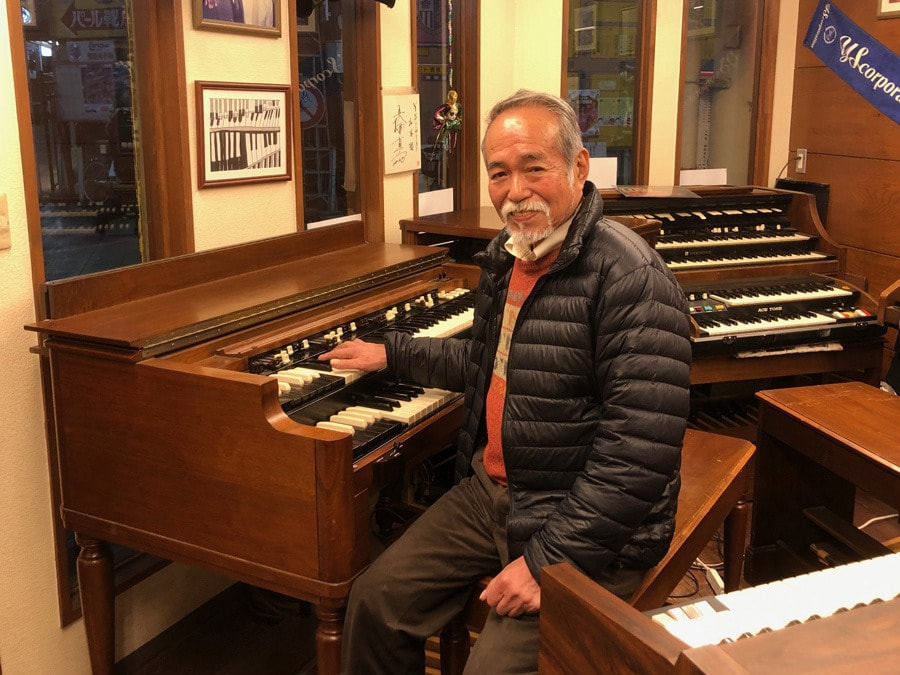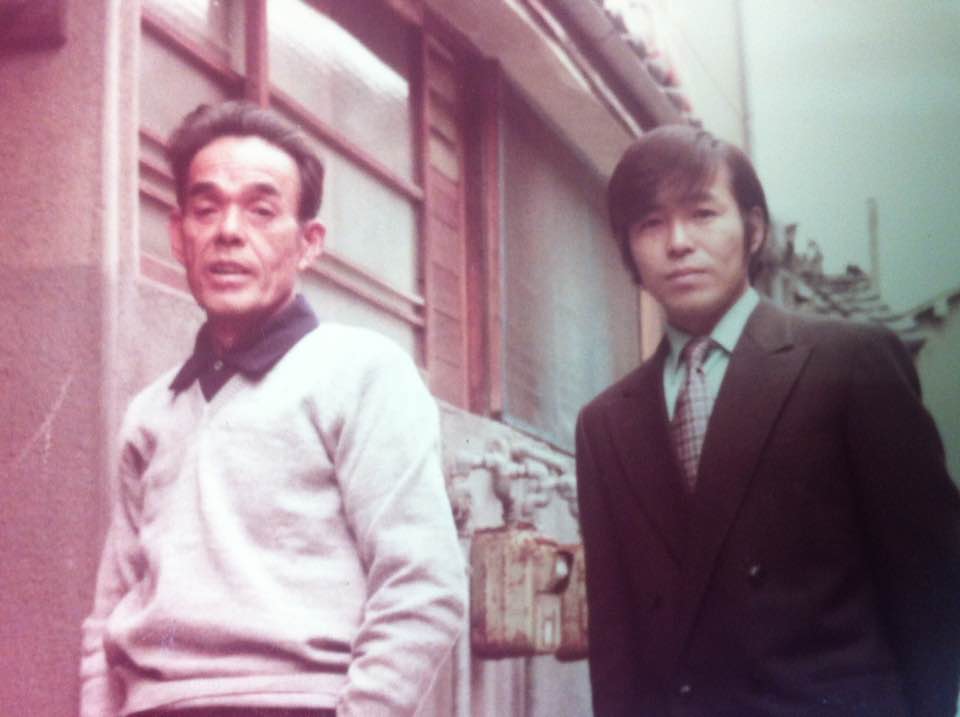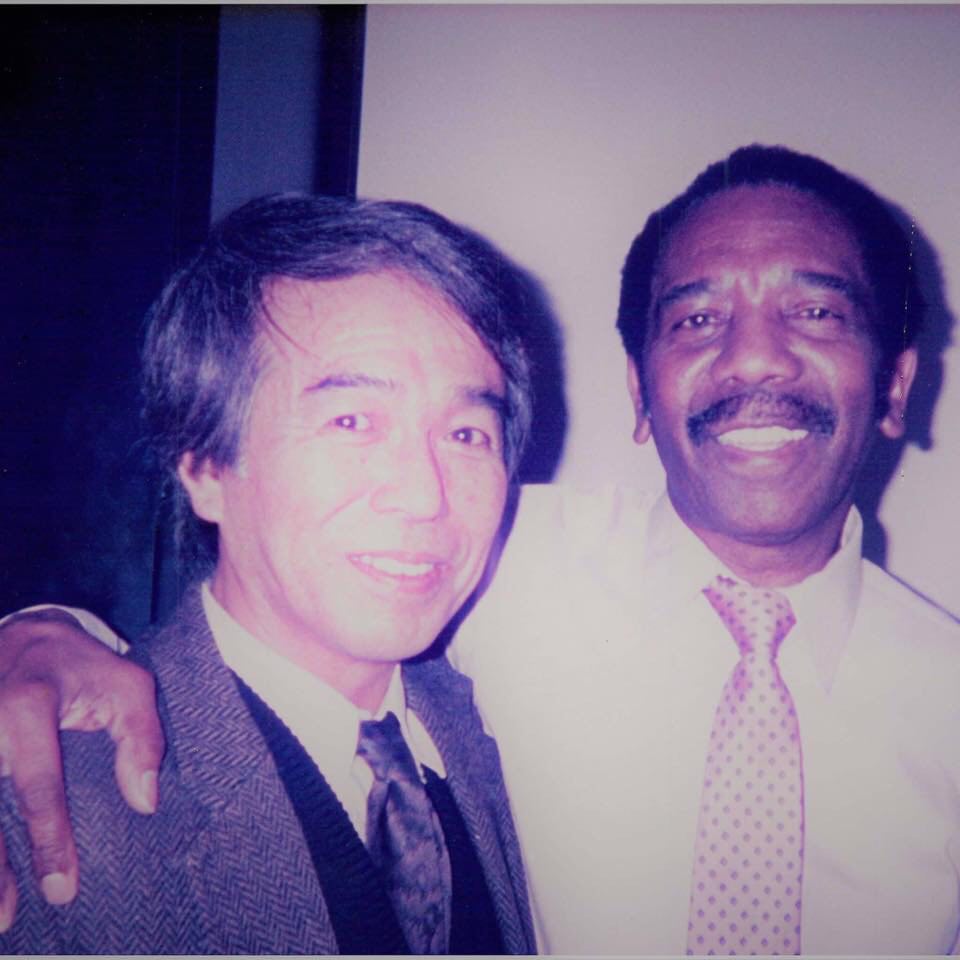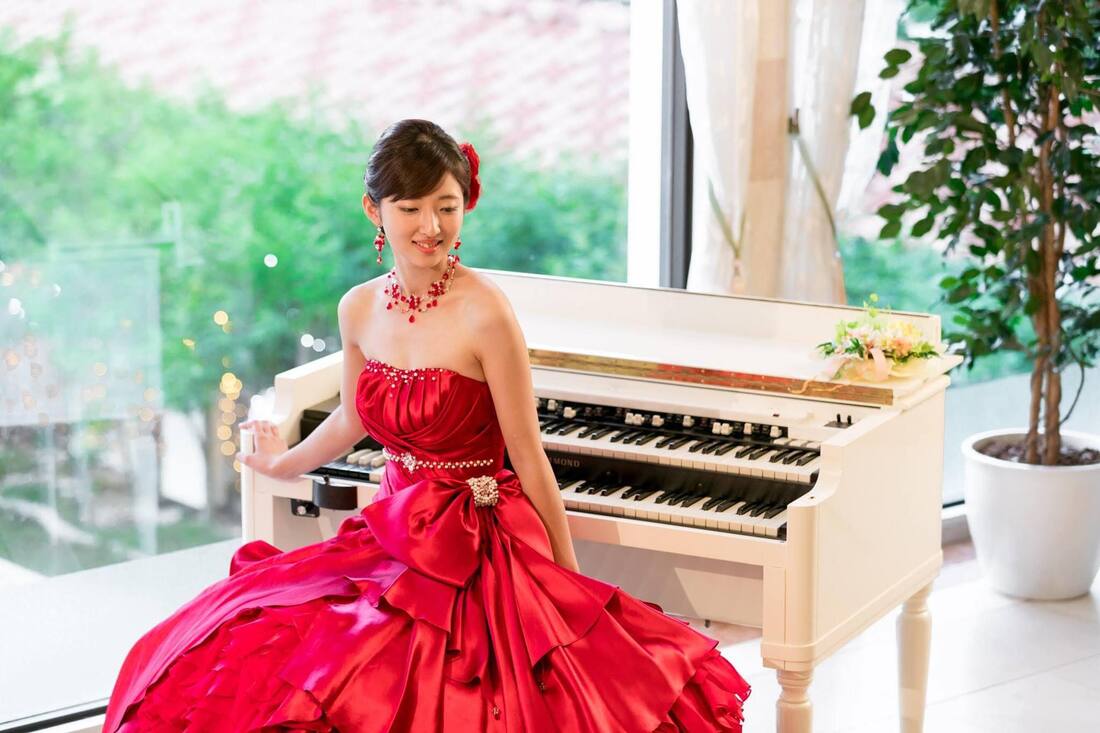Osamu Yamamoto
A Life Dedicated to the Hammond Organ
Osamu Yamamoto is one of the key figures who introduced and promoted the Hammond organ (jazz organ) in Japan. For over 50 years since he first heard the sound of the organ on the radio, he has been devoted to the Hammond organ. He runs a Hammond organ shop on a corner of the Nagai shopping district in downtown Osaka. When you open the door to the store, you see a showroom lined with glistening Hammond organs. In the far corner, there is Mr. Yamamoto's office. On the second floor, there are three soundproof lesson rooms. Organ, piano, and drum lessons are available from world-class performers.
The Life-Changing Sound of the Hammond Organ
|
Osamu Yamamoto
|
Osamu Yamamoto was born as the youngest of four children in Hiwasa-cho (now Minami-cho), Tokushima Prefecture, Shikoku Island, Japan in 1948. Hisawa is a town known for its beautiful coastline, famous as a spawning ground for sea turtles. Due to his father's transfer in the construction business, he moved to Osaka City when he was in elementary school, and has been living there ever since. He was an enthusiastic athlete since he was young, representing his school in swimming and track and field. In junior high school, he was a baseball pitcher who dreamed to one day become a professional player. However, when Enatsu, who later became a famous pitcher for the Hanshin Tigers, a professional baseball team, joined the team, he knew that he had reached his limit and decided to quit baseball. He then shifted towards more to music, he listened to the Beatles and Elvis Presley, having been influenced by his brothers.
|
|
He majored in Japanese history at university. He was fascinated by the Sengoku period (Japanese warring period 1467-1615), and his favorite warlord was Nobunaga Oda, who was one of the key figures to unite Japan. One day, as he was about to graduate from college, he heard the sound of a Hammond organ on the radio. The music played by Jimmy Smith (1925-2005), the Hammond organ jazz legend blew him away. As fate would have it, an ad for a sales position at a Hammond organ distributor called Ace Electronics Industries appeared in the newspaper shortly thereafter. That was the beginning of Mr. Yamamoto's Hammond organ career. It was 1970, in the midst of Japan's period of rapid economic growth.
|
20-year-old Yamamoto and his father
|
After joining the company, he became a real Hammond man, selling Hammond organs around Japan, training Hammond organ players, sending them out into the world, and even booking them. He became one of the leading Hammond organ dealers, which is unique not only in Japan but also in the rest of the world. His passion is one of the reasons why there are so many Hammond organs and excellent Hammond organists in western Japan.
Hammond Organ in 1970s - Growing Popularity
|
The Hammond organ is an electric organ invented by Laurens Hammond and John M. Hanert and first manufactured in 1935. Multiple models have been produced, most of which use sliding drawbars to vary sounds. Until 1975, Hammond organs generated sound by creating an electric current from rotating a metal tonewheel near an electromagnetic pickup, and then strengthening the signal with an amplifier to drive a speaker cabinet. The organ is commonly used with the Leslie speaker.(Wikipedia)
The sound produced by the Hammond organ is a unique synthesized sound with a rich airy deep sound, and it spread to churches in the United States where expensive pipe organs could not be installed. Gospel music adapted the organ early, and then spread to other genres such as jazz and rock. In Japan, William Merrell Vories (1880-1964), who is known as the businessman who imported mentholatum, became an importer and introduced the instrument. In particular, during the period of rapid economic growth, people were awakened to the music of the West, and the number of people who were devoted to the stylish sound of the Hammond organ multiplied. |
Hammond Organ B3 and Leslie Speakers
|
Mr. Yamamoto joined a company, Ace Electronic Industries Inc., which dealt with Hammond organs, and had an office in the Kitajima district of Suminoe Ward, Osaka City, a newly developed area reclaimed from rice fields. Mr. Yamamoto had to walk through muddy roads to get to work every time it rained . Ace Electronic Industries Inc. later changed its name to Japan Hammond Co., Ltd. and also developed its own Hammond-like instrument, the Acetone GT7, which was the first instrument in Japan with a drawbar that could be pulled and pushed to synthesize overtones into a sound. As popular Japanese bands played it, it became so popular that there were people waiting for it to be made at the factory. The Japanese economy was on the upswing, and more and more people were buying musical instruments for personal enjoyment. Mr. Yamamoto was in charge of sales, but it sold so fast and all he had to do was to deliver 5-6 instruments to the customers every day.
Appointed as Director of Hiroshima Sales Office
At that time, there were many women throughout Japan who were taking organs with them as part of their bridal kit, and demand was high even in the rural areas, so Mr. Yamamoto was transferred to Hiroshima to open the Hiroshima Sales Office. At that time in Japan, various companies began to manufacture and sell organs in response to the popularity of the organ, and Brother recommended the organ as a bridal kit along with their sewing machines. Toshiba produced an organ called the Orchestron, and National, which is now Panasonic, was manufacturing and selling an organ called the Technitone.
The B3 model, a mainstream Hammond instrument, was an instrument with a unique deep sound, and when Hammond players were brought in to play in a demo, those who understood the sound were amazed at the wonderful tone, and many bought the instrument. This American-made instrument cost about 3 million yen, including the speakers and body, and it sold like crazy even with its expensive price tag for the time. As the appeal of the organ spread, people who played the piano also bought organs, and more and more people who were new to keyboard instruments started with organs.
Competitors changed their models after about two years as electronic technology developed, but Hammond is a long-established company and has always been the same, so it has always had the same tone. Many people have remained loyal fans of the instrument without replacing it. People who bought them back then still come to Mr. Yamamoto's store from time to time. Now, he also buys organs that are no longer played.
The B3 model, a mainstream Hammond instrument, was an instrument with a unique deep sound, and when Hammond players were brought in to play in a demo, those who understood the sound were amazed at the wonderful tone, and many bought the instrument. This American-made instrument cost about 3 million yen, including the speakers and body, and it sold like crazy even with its expensive price tag for the time. As the appeal of the organ spread, people who played the piano also bought organs, and more and more people who were new to keyboard instruments started with organs.
Competitors changed their models after about two years as electronic technology developed, but Hammond is a long-established company and has always been the same, so it has always had the same tone. Many people have remained loyal fans of the instrument without replacing it. People who bought them back then still come to Mr. Yamamoto's store from time to time. Now, he also buys organs that are no longer played.
Meeting the World's Organists
|
The happiest time and most life changing moment for Mr. Yamamoto, since working with organs, was when he met Jimmy Smith and Dr. Lonnie Smith. In 1973 there was an organ concert at the prestigious Festival Hall in Osaka and later at the Blue Note in Osaka. Mr. Yamamoto was to lend out his organ, and that was the beginning of a relationship that later became a close friendship. The first time he heard Jimmy play live was a life changing blissful moment that he couldn’t express in words.
Mr. Yamamoto's passion for the organ gradually spread and he became friends with many of the world's top organists, including Brother Jack McDuff (1916 - 2001), Jimmy McGriff (1936 - 2008), Lonnie Smith (1942 - 2021), Tony Monaco (1959~) and Joey Defrancesco (1971 - ), and several others. The Japanese Hammond man, YAMAMOTO became well known in the world’s organ music community. |
Mr. Yamamoto and Jimmy Smith, the man who changed his life
|
One performer who had a memorable episode was Walter Wanderley (1932 - 1986), a Brazilian organist who came with a Brazilian samba team to the ongoing Flower Festival in Hiroshima when he was working at the Hiroshima office. After the festival was over, he was offered to play at the Sogo Department Store in Hiroshima. Mr. Yamamoto had established a connection with the Sogo Department Store, which had installed a top-of-the-line Hammond organ, the X-66, at the entrance to provide stylish music for their customers, so the store arranged for Wanderley to play at their rooftop beer garden. Bossa Nova music, which is a fusion of Brazilian samba and American jazz, was popular all over the world, and Mr. Yamamoto was so excited to hear this top performer play. Excited to meet the performer of his dreams, he invited him to dinner before the performance and had a wonderful conversation. They were having so much fun that they lost track of time and were an hour late for the performance. They rushed to the venue and hurried to start the performance, but it was relieving that they didn't say anything. Needless to say, the two sets of the performance were overwhelmingly well received.
He also held a workshop with Wanderley that was very well recieved.
He also held a workshop with Wanderley that was very well recieved.
Returned to Osaka Head Office and Established Own Business.
The Hammond organ was selling like crazy, but as history has shown us, things came to an end. The popularity of the Hammond organ began to wane, and sales began to decline. Business at the head office was not going well, and Mr. Yamamoto, who had been excelling at the Hiroshima sales office, was sent back to the Osaka head office. In Hiroshima, he was able to plan concerts at his own discretion and sell the organ to people who actually listened to it and liked it, but at the Osaka head office, the only way was to sell the instrument, which proved to be difficult at that time. He tried his best, but it was already too late. In the end, Hammond Japan closed in 1986, and the Hammond organ was taken over by a company called Suzuki Musical Instruments, now based in Hamamatsu City, Shizuoka Prefecture.
With that as a starting point, Mr. Yamamoto decided to go independent and start his own business. The B3, a hot-selling model of Hammond organ, had been discontinued in 1975, so he decided to import second-hand organs from the US and sell them. His brother, who worked for a shipping company, taught him about the import business. Soon after thatpa- he obtained a secondhand goods dealer license, he established “YS Corporation”. The "Y" stands for Yamamoto, and the "S" stands for Sugisawa, the name of the engineer who did the repairs.
He bought used Hammond organs in the U.S., packed them in a container, imported them, and sold them. Mr. Yamamoto's business got off to a good start, with many people who were musicians and music school owners buying them.
The B3 model, the pinnacle of Hammond organs, sold for 2.2 million yen for the main unit and 350,000 yen for the Leslie speakers, for a total of 2.5 million yen in Japan. It sold very well.
Mr. Yamamoto, an idea man, organized a full-scale jazz organ class using the B3. He advertised it in magazines and held presentations, and people who were interested began to come to take lessons. YS Corporation also made efforts to train performers who could pass on the sound of the Hammond organ. His company provides a place for organ, piano, drums, and other instruments, to be nurtured and brought up to be great musicians. Both young children and adults take classes. Notable names such as Neo Yamada, Nonoka Nagao, and Terumasa Yasuda, all of whom are excellent students who will carry the future of jazz in Osaka. In addition, he provided a place for students to not only learn the organ, but also for those who have studied the organ to become active teachers. He also booked a variety of live music venues so that organists could perform live, plan festivals, and execute other exciting ideas one after another. As a result, the number of live music venues in the Kansai area equipped with Hammond organs has increased, and even today, organists continue to perform live at those live music venues with the B3 model organ. Mr. Yamamoto's passion for the organ has spread, and the Kansai area of Japan has become one of the meccas of the jazz organ, which is rare in the world.
With that as a starting point, Mr. Yamamoto decided to go independent and start his own business. The B3, a hot-selling model of Hammond organ, had been discontinued in 1975, so he decided to import second-hand organs from the US and sell them. His brother, who worked for a shipping company, taught him about the import business. Soon after thatpa- he obtained a secondhand goods dealer license, he established “YS Corporation”. The "Y" stands for Yamamoto, and the "S" stands for Sugisawa, the name of the engineer who did the repairs.
He bought used Hammond organs in the U.S., packed them in a container, imported them, and sold them. Mr. Yamamoto's business got off to a good start, with many people who were musicians and music school owners buying them.
The B3 model, the pinnacle of Hammond organs, sold for 2.2 million yen for the main unit and 350,000 yen for the Leslie speakers, for a total of 2.5 million yen in Japan. It sold very well.
Mr. Yamamoto, an idea man, organized a full-scale jazz organ class using the B3. He advertised it in magazines and held presentations, and people who were interested began to come to take lessons. YS Corporation also made efforts to train performers who could pass on the sound of the Hammond organ. His company provides a place for organ, piano, drums, and other instruments, to be nurtured and brought up to be great musicians. Both young children and adults take classes. Notable names such as Neo Yamada, Nonoka Nagao, and Terumasa Yasuda, all of whom are excellent students who will carry the future of jazz in Osaka. In addition, he provided a place for students to not only learn the organ, but also for those who have studied the organ to become active teachers. He also booked a variety of live music venues so that organists could perform live, plan festivals, and execute other exciting ideas one after another. As a result, the number of live music venues in the Kansai area equipped with Hammond organs has increased, and even today, organists continue to perform live at those live music venues with the B3 model organ. Mr. Yamamoto's passion for the organ has spread, and the Kansai area of Japan has become one of the meccas of the jazz organ, which is rare in the world.
|
Ms. Yamamoto has long been involved in helping Japanese professional organists such as Atsuko Hashimoto and Midori Ono, touring and playing at jazz festivals in the USA. He also organized organ shows with foreign musicians as well as organizing international organ summits in Japan.
He also had installed a large scale theater organ, the Arlen Theater Organ, which used to accompany silent movies, in a large shopping mall called Herbis in Osaka, and he installed a Hammond organ in a wedding hall in Kyoto to produce a wedding ceremony with elegant live Hammond organ music. |
A white Hammond organ in the wedding hall
|
A Life Full of Accomplishment and the Future
"When I look back on my life, I have done everything I wanted to do," said Mr. Yamamoto, his face full of satisfaction.
Mr. Sugisawa, with whom he shared his organ life, passed away a few years ago, and he is now the sole owner of a Hammond organ showroom in the Nagai shopping street. Although he is now alone, the organ lovers who have been inspired by Mr. Yamamoto's passion frequently visit the shop, and some of them are interested in becoming his successors.
The Hammond organ appeared like a comet in the history of music as one of the first electronic instruments, and many instruments imitating the Hammond organ, such as Yamaha's Electone and Kawai's Dorimatone, have been developed for the next generation. Mr. Yamamoto has contributed greatly to the jazz organ culture in Japan and beyond.
Mr. Sugisawa, with whom he shared his organ life, passed away a few years ago, and he is now the sole owner of a Hammond organ showroom in the Nagai shopping street. Although he is now alone, the organ lovers who have been inspired by Mr. Yamamoto's passion frequently visit the shop, and some of them are interested in becoming his successors.
The Hammond organ appeared like a comet in the history of music as one of the first electronic instruments, and many instruments imitating the Hammond organ, such as Yamaha's Electone and Kawai's Dorimatone, have been developed for the next generation. Mr. Yamamoto has contributed greatly to the jazz organ culture in Japan and beyond.
YS Corporation
5-14, Nagai 3-chome, Sumiyoshi-ku, Osaka 558-0003, Japan
Nagai Shopping Street
(2 minutes walk from JR Nagai Station, 5 minutes walk from Subway Midosuji Line Nagai Station)
tel: 06-6696-2684
fax: 06-6606-6656
email: ysorganb3@gmail.com
website: http://www.ys-co.org/
by Yuki Maguire
5-14, Nagai 3-chome, Sumiyoshi-ku, Osaka 558-0003, Japan
Nagai Shopping Street
(2 minutes walk from JR Nagai Station, 5 minutes walk from Subway Midosuji Line Nagai Station)
tel: 06-6696-2684
fax: 06-6606-6656
email: ysorganb3@gmail.com
website: http://www.ys-co.org/
by Yuki Maguire
|
threetreerecords@gmail.com
Telephone901-825-8127
|





